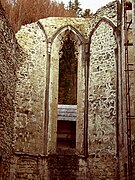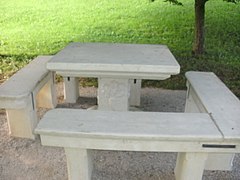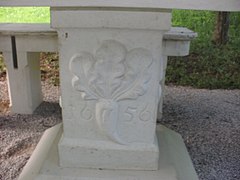Žiče Charterhouse

Žiče Charterhouse, also Seiz Charterhouse (
The Žiče Charterhouse was the first Carthusian monastery in the German sphere of influence of the time, and also the first outside France or Italy.[2]
Charterhouse foundation and foundation deed
The Žiče Charterhouse was founded between 1155 and 1165 by
Pseudoetymology

The following legend is a
Name
Over the centuries, the name Žiče Charterhouse appears in early written documents in various forms: Seitz (1185), Sitze (1186, 1243), Seiz (1202, 1234), Sishe (1229), Seitis (1233), Sits (1235, 1257), Siz (1237), Syces (1240), Sic (1243), Syces (1245), Siths (1247), Seits (1257)
Architecture of Žiče Charterhouse

Lay monk Aynard, construction master sent from Grande Chartreuse, influenced much to the arrangement of the premises. The first emergency Charterhouse buildings were built until at least 1165. The scheme or Chartusian monasteries usually comprised three basic elements: monastic church, a small cross corridor (Lesser Cloister) and a great cross corridor. As with first French charterhouses, two monasteries were built here.
Upper one (Domus Superior), where the cloister monks used to live according to the strict rule of the Carthusians, they spend time in contemplative prayer and individual work in their cells. Great Cloister linked monastic cells and there was a God's Acre also, where monks were buried. In Žiče Charterhouse there was a crucifix, placed in the middle at first. In 15th Century the crucifix was removed and replaced by cemetery chapel, where priors were buried, which has been preserved until now. Lesser Cloister linked communal rooms and served as an entrance to the St. John the Baptist church and Sacristy. Communal rooms, such as Chapter house, Refectory (common dining room), a kitchen, a Dormitory (a bedroom for lay brothers, who participated at the liturgy on holidays and Sundays) were built around the Lesser Cloister.
Lower one (Domus Inferior) in the settlement of
History
The monastery was settled by Carthusian monks and lay monks from the Grande Chartreuse near Grenoble in France, led by prior Beremund, count of Cornwall, royal relative, prior of Durbon Charterhouse in Provence.
Roman
Stephen Maconi
The Carthusian prior general,
Philipp von Seitz
About 1300
The monastery was attacked during an Ottoman raid in 1531. This marked the beginning of a decline in its influence and fortunes. In 1564 it passed into the hands of commendatory priors and in 1591 to the Jesuits of Graz. It was recovered by the Carthusians in 1593, after which it prospered again.


In 1782 Emperor Joseph II abolished the monastery, one of the earliest to be dissolved under the Josephine Reforms. The charterhouse was allowed to fall into decay. When the charterhouse was dissolved, an inventory was also made of the Žiče pharmacy, which was equipped with a wide variety of medicines and other material.[9]
The ruins of the Žiče Charterhouse were bought at auction from Imperial Religious Fund (Religionsfond) in 1826 by Prince Weriand of Windisch-Graetz and remained the property of this family until the end of World War II. Today's owner of the Žiče Charterhouse is the Municipality of Slovenske Konjice.
Monastic churches
The monastic Carthusian church was dedicated to
Also monastic church of Mary's visitation in Špitalič (Ecclesia Minor) was consecrated in 1190. It was built in the French late Romanesque style and has remained almost unchanged until today.
-
Gothic window of monastic church
-
Side nave apse
-
Sundial
-
Main arch portal, Visitation Church, Špitalič
-
Lunette of the arch portal
Library
Soon the monastery became a center of culture and politics in its territory and far beyond. On 30 May 1487, the visiting
Žiče manuscripts

The Carthusian order never preached religion through the spoken word, but took to spreading it in writing, accepting into the order only people with a good knowledge of foreign languages (mostly
Despite the loss of most of the manuscripts, the remnants of impressive library can still provide a valuable insight into several centuries of continuous development of the medieval book. Today about 120 manuscripts and 100 fragments are known. This is only a fraction of the whole, and even this small part is almost entirely outside Slovenian borders. Yet this is the only group of medieval manuscripts from Slovenia, making it possible to follow nearly four centuries of unbroken manuscript production within one monastic community. The manuscripts from the Žiče Charterhouse include many notable texts written by authors living in Žiče or the nearby Jurklošter Charterhouse. Examples include texts by Phillip of Žiče (Seitz), Nicolaus Kempf, and Sifried of Swabia.
Several of these manuscripts are also signed by monks or copyists from outside, who were probably benefactors, and their hand-written works makes of rich palette of
Gastuž Inn

Guests or visitors were always taken outside the charterhouse walls. After the dissolution of the monastery in Špitalič, guest were welcomed in the Gastuž Inn, purporting to be the oldest inn on Slovenian territory (dating to 1467).
Present day
Today the Žiče Charterhouse is an important historical and cultural monument with about 20,000 visitors per year. Reconstruction work under expert supervision is still in progress. In accordance with modern processes nowadays Žiče Chaterhouse hosts many cultural events during summer, even wedding, trying to revitalise historical memory to the chartusians in this area.
On the occasion of 850th anniversary of Žiče Charterhouse foundation deed, Charterhouse was proclaimed a cultural monument of national importance on 24 June 2018, by the Government of Republic of Slovenia.
-
Ruins of former monastic cells and common building
-
Former Great Cloister with All Saints cemetery chapel
-
Defense walls with tower
-
Cemetery chapel, detail
-
Monastic church of St. John the Baptist
-
Winged ox relief
-
Žiče Charterhouse from monastic Herb Garden
-
Monastic table from 1656, replicated
-
Monastic table from 1656, detail
Notes
- ISSN 0253-1593.
- ISBN 978-961-92153-0-2.
- ^ As with most medieval monasteries there is a foundation legend, which in this case relates that Ottakar was led to the site when he became lost in dense forest during a hunt.
- ^ The bodies were later moved to Rein Abbey
- ISBN 978-961-6448-16-1.
- ISBN 978-961-6448-16-1.
- ISBN 978-1-391-48339-9
- ^ Hofmeister, Wernfried. "Steirische Literatur im Mittelalter | Philipp v. Seitz: Marienleben" (in German). Retrieved 2018-09-19.
- ^ Zdovc, Vinko: Žička kartuzija, Kratka zgodovina bogate preteklosti kartuzije 1165-1782. Slovenske Konjice 1997
- ISBN 88-8147-202-3















